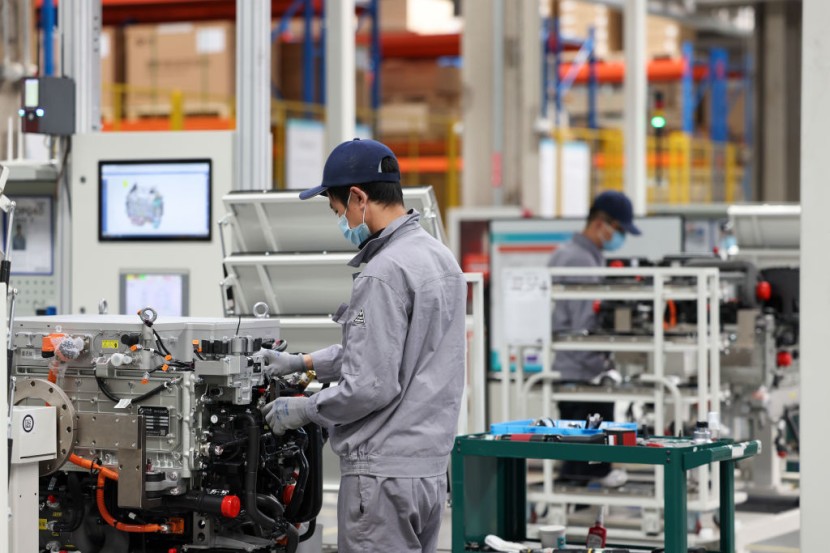
By converting seawater into hydrogen and oxygen, a team of Chinese scientists has taken a step forward in the pursuit for pure, renewable energy.
Xie Heping, a researcher from Shenzhen University, and the state-owned Dongfang Electric Corporation oversaw the development of an offshore platform that harnessed both wind and solar energy in the first successful attempt to use seawater without desalination.
How China's Floating Hydrogen Farm Works?
The "Dongfu Number One" platform is anchored in the waters of southeastern China, off the coast of Fujian province, and is able to withstand large surges and winds of up to Beaufort 8 strength.
Per SCMP, the 63 square meter (678 square foot) platform integrates a hydrogen production system with an offshore wind energy supply system. By combining the two components, the researchers created an eco-friendly floating farm that electrolyzes seawater into hydrogen without producing harmful byproducts or polluting the environment.
In November, Xie's team, the creators of the hydrogen production technology at the foundation of the platform, published an article in the peer-reviewed journal Nature detailing the process. Seawater is difficult to manipulate due to the intricacy of its composition. It is full of microorganisms and suspended particulates, which frequently results in low electrolysis efficiency and a shorter longevity for the equipment.
Previous initiatives, including those in the Netherlands and Germany, have frequently relied on desalinating seawater and then utilizing the freshwater for hydrogen production. This method, however, adds complexity to the process by necessitating extensive desalination apparatus and vast land resources, which increase the cost of producing hydrogen and the difficulty of constructing a project.
Multiple sources report that hydrogen has been successfully produced through the electrolysis of seawater on a floating offshore platform in Fuijan Province, east China.
During a test conducted by Dongfang Electric Corporation, a state-owned manufacturer of wind turbines, a floating platform with electrolysis capacity produced hydrogen for more than 240 hours, according to H2. China Global Television Network (CGTN) reported that a team of experts from the Chinese Academy of Engineering verified the test results (CAE). H2 View has contacted Dongfang Electric Corporation for additional information regarding the test.
According to reports, the systems endured winds of force eight, waves one meter high, and downpours. Typically, electrolysis for hydrogen production requires ultrapure water. In the majority of initiatives employing seawater, desalination apparatus is typically installed.
An international team of researchers led by Professor Shizhang Qiao and Associate Professor Yao Zheng from the University of Adelaide's School of Chemical Engineering announced earlier this year that they had effectively produced green hydrogen by splitting seawater without pre-treatment.
Read Also : D
China Expects Hydrogen Demand to Increase to 100 Million Tons
Per Up Stream Online, China will construct an integrated pipeline network to transport hydrogen produced in the northern and northwestern regions of the country, which are wealthy in wind and solar energy, to markets in the south and east, in response to the enormous demand for hydrogen.
Li Guohui, vice president of China Petroleum Pipeline Engineering Corporation (CPPEC), stated last week at China's World Hydrogen Technology Convention in Foshan, Guangdong province that China anticipates its total hydrogen demand to increase to 100 million tons annually by 2060.
However, China's hydrogen plants are located in the northwest, northeast, and midwest, which is rich in solar and wind resources and is also the center of China's refining and chemical industries, whereas the demand centres are in the east and south, necessitating the transportation of hydrogen, whether it be grey or green, to these markets.
Li added that all hydrogen produced in China will be transported through a 6,000-kilometer pipeline network by 2050, connecting the regions, provinces, and cities of northern China's Ningxia, Inner Mongolia, Hebei, Beijing, Tianjin, and Heilongjiang.
As a national hydrogen pipeline infrastructure, it would be available to hydrogen asset owners and traders, according to him. Sinopec will construct one of the pipelines to transport renewable hydrogen produced in Inner Mongolia to consumers in Beijing. This West-East hydrogen conduit will stretch 400 kilometers from Ulanqab, Inner Mongolia to the Sinopec Yanshan Petrochemical in Beijing, passing through nine counties and three provinces.
The proposal calls for the construction of an onshore wind farm, an electrolysis system that uses wind energy to produce hydrogen, and an export conduit. First-phase hydrogen pipeline throughput capacity will be 100,000 tpa, expandable to 500,000 tpa in a later phase.
© 2025 HNGN, All rights reserved. Do not reproduce without permission.








